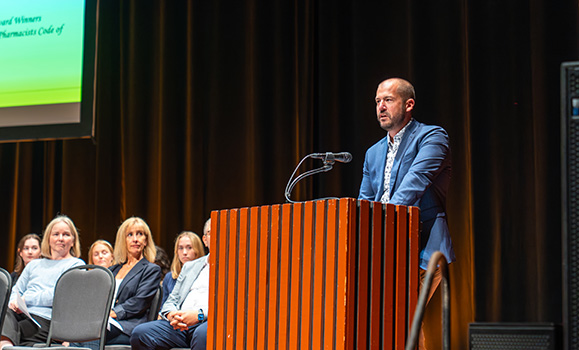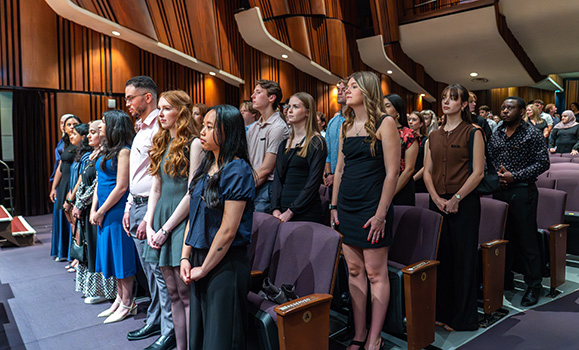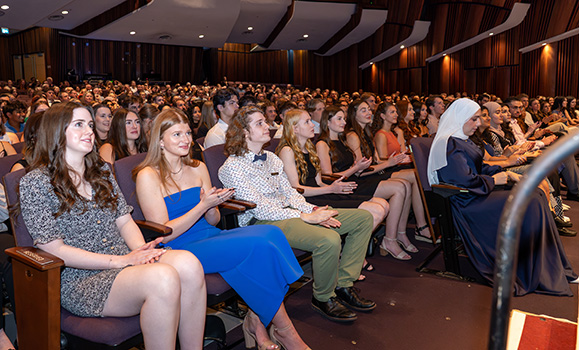ƒ¢πΩAV‚Äôs College of Pharmacy is changing the way it welcomes new students, helping future pharmacists provide culturally responsive care.
For the past few decades, new students were welcomed into the college during a white coat ceremony where everyone was given a coat to wear for their labs. The tradition began in medical schools and was adopted by pharmacy programs because pharmacists also wear white coats.Ã˝
The white coat ceremony has been the norm at most pharmacy schools across North America, but no longer at Dal.
Students entering Dal‚Äôs pharmacy program will now get to mark the moment by receiving a cherry tree saplings, which they are expected to nurture during their schooling.Ã˝
The white coat has negative implications and puts the pharmacist on a different level than the patient
Dr. Kyle Wilby, director of the College of Pharmacy, says cherry trees were chosen because they are native to Nova Scotia, have medicinal properties, and are used in traditional medicine.
“It's creating a new tradition that allows pharmacy students to understand the roots of the profession, with something that is more specific to us than a white coat,” he says. “We are drawing on the medicinal properties of the world around us.”
Students will also mark the end of their education with another tradition such as planting the trees in a forest to symbolize the growth that occurred during their years on campus, says Dr. Wilby.

Dr. Kyle Wilby delivers remarks at the College of Pharmacy welcome ceremony.Ã˝
Pharmacy students will still receive white coats during their education that they can wear in labs, but it won’t be celebrated at a ceremony.
Reason for the change
Dr. Wilby says for pharmacists to be on equal footing with patients and to provide better patient-informed care, there have to be some systemic changes.
“The white coat has negative implications and puts the pharmacist on a different level than the patient. People have had negative experiences of discrimination and harm, and it might be a reminder.”
He says the tradition was initially created to celebrate entry to the profession, but in modern day it feels out of date.
“We received positive feedback by many partners in practice, including people who work with pediatrics, mental health and 2SLGBTQ+ communities who don’t wear white coats at all,” he says.
“There’s even a condition called white coat hypertension — when people get their blood pressure measured, the coat stressed them out because they were in this clinical setting.”
He says the goal is to create an environment within the university and health-care settings where all people feel welcome and can receive the highest quality of health care possible.

Response from students and pharmacy partners
Dr. Wilby says they took away the white coat portion of the welcome ceremony last year but didn‚Äôt fully explain why in advance, so there was some disappointment among students who wanted to experience that tradition.Ã˝
This year, he is excited about the cherry trees and to explain why it’s important not to put the focus on the coat.
Rose Dipchand (BSc’93, Pharm’97), senior director, Pharmacy & Professional Affairs at Pharmasave East, applauds Dr. Wilby’s decision. She says the white coat can bring up a wall between the patient and pharmacist, and there are cultures with generations of trauma and distrust of medical or health authorities.
“Some people say we worked hard for a white coat. No, I didn’t work hard for the white coat. I worked hard for the privilege and honour to become a pharmacist and help people,” she says.
I didn’t work hard for the white coat. I worked hard for the privilege and honour to become a pharmacist and help people.
Dipchand says the white coat is seen as a sign of professionalism, but putting on the garment doesn’t mean you’re automatically ready to take on that responsibility.
“We need to find our professional identity, which changes over time,” she says. “It shouldn’t be tied to the white coat.”
She says no one wants to dampen the experience of incoming students who are excited to wear the white coat, but instead we‚Äôre showing them other choices. They can still wear a white coat, but they can also decide to wear colourful scrubs or other clothing and be equally professional.Ã˝
Inspiration from other universities
Dr. Christine Landry, director of the Undergraduate Doctor of Pharmacy at University of Ottawa, says Dr. Wilby and ƒ¢πΩAV have led the way to make the change at other institutions.
The university’s pharmacy program was already considering making this change, and Dr. Wilby’s experience and guidance helped them plan for it. Now, both the pharmacy and medical schools at uOttawa will move away from the white coat ceremony.
They will be offering students items — a stethoscope for medical students, mortar and pestle for pharmacists and a compass for graduate students — to be more representative of their professions, which is how Dr. Wilby got the idea for the cherry trees.
Dr. Landry says it’s important to move forward, and just because something has been done for years, doesn’t mean it shouldn’t be questioned and changed.

Students attending their welcome ceremony.
She explained that the decision was done in talks with different community partners, including indigenous members, to support reconciliation and ensure that pharmacists provide culturally safe care.Ã˝
“It was the main question at our orientation from our students, ‘Why aren’t we getting our white coat?’ and we explained you will still receive one but we aren’t celebrating it. We are celebrating you entering the profession.”
Dr. Wilby is thankful to the many community partners, university leaders and students who collaborated with him to make this change.Ã˝
“Change can be hard, but the more we create new traditions, the better we can educate,” Dr. Wilby says. “It's exciting to listen to our community members and patients to facilitate change that can not only break down barriers but can start something new. I am proud. Even though this was hard for me to do in my first year as director, I’m glad we did this.”

